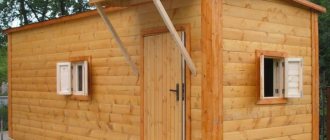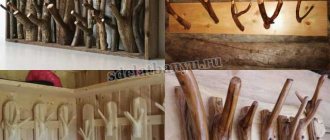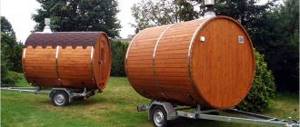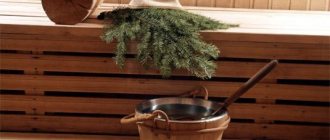We have already mentioned the fact that most of the time a person spends going to the bathhouse is spent not in the steam room, but in the dressing room or relaxation room. And in these rooms the most important piece of furniture is the table. This unique king of the feast can be a standard one, purchased at a nearby supermarket, or it can be unique down to the last piece, made independently. Today, we choose a table for the bathhouse, meticulously and competently.
When shape and size matter
It must be said that a bathhouse, in most cases, has quite limited dimensions of the interior spaces and this circumstance must be taken into account when making superficial design sketches or when serious and detailed interior design. In any case, it is necessary to take into account the unwritten rules of the domestic bath tradition:
- The table for the bath, however, like the rest of the bath decoration, should be as practical as possible. If you are faced with a dilemma between choosing an elaborate and elegant one or a modest but very comfortable one, give preference to the second. You will never regret it.
- The interior decoration of a real bathhouse should be natural. You should also not overuse various decorative chemicals, which give simple wood the charm and shine of exotic varieties. Believe me, there are many ways to refine wood without resorting to impregnations, stains, paints and varnishes. An exception may be perhaps completely substandard wood, the defectiveness of which should be masked with the help of global toning. And objects treated in this way should be located away from the steam room, with its temperature and humidity.
- Internal space should be used rationally. Surely it’s worth sacrificing one seat, rather than all the participants in the feast experiencing global inconvenience.
- If the interior space, after installing the furniture, in particular the table, looks excessively cramped and cluttered, then it is necessary to use bath tables with high legs and focus the visual perception on the horizontal elements of the structure.
- When placing such a large object as a table in the internal volume, always use the golden rule - the farther from the steam room, the better and more durable.
- Don't get hung up on stereotypes and dogmas. You need to feel free to experiment. For example, with wicker furniture. Lightness, openwork, naturalness, along with sufficient strength and durability make you look closely at objects of this type. Leather furniture can also be good, but only natural, with sufficient strength and resistance to the difficult conditions of a bathhouse. It is necessary to select an appropriate table for it, which will look harmonious and natural, framed by leather splendor.
Special DIY bath soap
In order to make fragrant soap with your own hands, you need one hundred grams of soap base. Melt it and mix with aromatic oils, such as jojoba oil. Add 3-4 drops of glycerin and a few tablespoons of dry seaweed on top of the base. Finally, add essential oils, such as fir or tea tree oil.
Mix the resulting mass and pour into molds. Soap molds can be completely different, but we recommend using the original molds. Then, in addition to the wonderful smell, the soap will also be beautiful.
This soap will cleanse your skin and make it softer and more moisturized. After swimming you will feel absolutely wonderful.
We hope that you have decided which bath accessories are best to make yourself. In a well-equipped bathhouse you will enjoy not only bathing, but also a pleasant time in an environment that you created with your own hands.
Wooden bath furniture is sold in any store today. If you want an interior according to your own design, you can draw up drawings and diagrams, and the manufacturer will make custom-made furniture for you. But if you want to furnish a sauna or bathhouse in a truly original way, then you need to do everything yourself. The simplest instructions, assembly features and video tips are below.
Wooden splendor
The wooden bath table continues to be an unfading classic of the genre of domestic bath interior. Wooden objects have many advantages:
- High ecological purity of the product, its naturalness and naturalness in the interior decoration;
- Low thermal conductivity and heat capacity, which is a very valuable quality in relation to the realities of a Russian bath;
- A wooden table for a bathhouse has the necessary margin of strength and natural durability with relatively simple and unpretentious maintenance;
- Wood is easy to process and to work with it you need a fairly small list of available tools.
To be fair, it is worth mentioning the use of other materials from which it is theoretically possible to make a bath table:
- Plywood and MDF are unique substitutes for solid natural wood, in the production of which various chemicals are used, including alkyd resins;
- Plastic - some of its types, manufactured to food grade tolerances, are suitable for the production of furniture and tables in particular. Products based on plastic masses are durable, lightweight and sufficiently strong. Caring for them is easy. However, the presence of plastic in the bathhouse interior negates the charm of the bathhouse itself;
- Metal - due to the characteristics of steel, cast iron and tables made of non-ferrous metals and their alloys, their presence in the bathhouse is appropriate in the form of individual elements, but not the structure as a whole.
Types of wood for making bath tables
A wooden table for a bath is made from certain types of industrial wood that have the necessary consumer qualities. These include the following:
- Linden. A pleasant, easy-to-work wood with well-structured wood of uniform color and a pleasant aroma. Retains its original qualities for a long time;
- Alder. Wood of this species should also be classified as a priority. It is easily and predictably processed, and is satisfactorily resistant to warping under conditions of frequent temperature changes. The wood texture has an attractive appearance with minimal decoration and processing. When choosing commercial raw materials, special attention should be paid to the degree and quality of drying; for alder raw materials this is fundamental and important;
- Aspen. It is distinguished by good quality solid wood, in which knots and other serious defects are rarely found. Materials of this type are affordable and well processed. Among the disadvantages, it should be noted the tendency to warping and drying out. It is worth remembering that aspen tabletops do not withstand significant mechanical loads very well;
- Poplar. In terms of their characteristics, materials made from this type of wood are close to aspen. However, despite being cheap and accessible, poplar products are not particularly durable;
- Oak. It’s especially nice to make a table for a bathhouse with your own hands from this wood. Its noble color, deep original texture, and spicy oak aroma distinguish it from a host of other species. Excellent strength and record durability put oak furniture beyond competition. The disadvantages include the high cost of conditioned wood and the tendency to split when fastened with self-tapping screws.
A word from Experienced! You can avoid chipping when fastening with self-tapping screws by pre-drilling. Drilling of the fastening channel is carried out with a tool whose diameter is 25% smaller than the diameter of the self-tapping screw used.
It is worth mentioning separately about the use of coniferous wood in our carpentry practice. Spruce and pine are among the most affordable lumber on the domestic market. However, making a table for a bathhouse with your own hands from such raw materials is not always rational. Firstly, all conifers are quite resinous, secondly, it is unlikely to obtain a beautiful and bright texture without subsequent processing and, finally, using them in conditions of high humidity means dooming them to a short life. From coniferous wood, it is worth using cedar and larch, and the latter is more preferable in terms of the cost of raw materials.
Basic criteria for choosing bath accessories
A rack with bath accessories is available in almost every supermarket with a department offering household goods. Specialized stores offer a wide range of bath accessories. Buckets for soaking brooms, tubs and basins for water will come in handy and make visiting the steam room efficient and convenient.
The main thing you need to pay special attention to when choosing bath accessories is the quality of the products. The bathhouse is characterized by high temperatures and high humidity. The accessories you choose must withstand regular use in extreme conditions, so it is not recommended to skimp on them.
Bath accessories are made from different materials, the most popular of which are:
Each of the above materials has its own advantages and disadvantages.
Choosing the shape of the tabletop and legs
The design idea is played out around two main elements of the table design: the table top and its legs.
When discussing the shape of countertops, we can distinguish several main, key types:
- Round - they look original, they unite the bath company in the manner of King Arthur’s knights, but they set strict requirements for the usable area of the rest room. It is worth remembering that a table for a bathhouse with your own hands, which has radius elements in its design, is much more difficult to process than rectilinear ones;
- Oval - in terms of the totality of consumer qualities, they are close to round, but are even more demanding on the space of the room. An important positive quality of both types of tables is the complete absence of sharp corners, which has a beneficial effect on the level of household injuries in the conditions of a particular bathhouse;
- Square and rectangular are classics of the bath genre. They are compact and practical, more convenient to manufacture and finish than their curvilinear counterparts.
The next component of the table, on which, in fact, the tabletop rests, are the legs. Their variety is small and the main types should be considered as follows:
- A table with four legs is a classic design. Allowing maximum stability over a large area. This solution frees up space under the tabletop, providing ample freedom for the legs of the participants in the feast;
- A table with three legs is a less common solution. Due primarily to the insufficient stability of the entire system as a whole and requiring the use of a tabletop of a certain shape;
- A table with two legs is a simple and well-deserved design. Suitable for massive countertops in a simple rustic style. The overall strength of the table is determined by the use of additional fastening elements, which somewhat limits the free space below;
- Table with one central leg. This solution is applicable for round and oval-shaped countertops. For acceptable stability, the surface area of the table should be limited to accommodate a group of 4 people.
Bath broom
Perhaps the most important element of the room. The best solution is to make a broom yourself, then you can have no doubt about the benefits of the product and its environmental friendliness. Branches of any tree or medicinal herbs are suitable as the main material.
The classic option is tightly tied oak or birch branches, but they need to be prepared correctly so that the broom holds tightly. It is better to pick branches with young foliage around July.
For the bundle, not too thick, but flexible branches of approximately 40-60 cm are suitable. Of course, you can use shorter branches, but tying them together will not be so easy. In addition, short branches may fall out of the bundle. Now let's start making the broom.
Before joining the branches, you need to clear the lower part of the branches from small twigs and leaves. Remember to shake the branches from time to time to maintain their volume.
The branches must be connected with twine or other strong threads. Tighten the initial bundle closer to the end of the branches, and the second one closer to the top. The right side of the broom, divided into two parts, should be pulled to the left through the bottom, and the left side to the right through the top, then the branches will be firmly connected and will not carelessly stick out in different directions. Do this several times.
For the second bundle, you need to choose the same thread, but longer and tie it even tighter. Check the strength of the product and, at the end of the process, evenly trim the branches protruding at the end.
After making the bath broom, you should hang it in a dry, warm place to dry, for example, in the attic. You can wrap the leaves in paper to make them more brittle. Of course, you need to hang the broom with the handle up. You can store the product in a closet or drawer, preferably away from dampness, otherwise it will begin to mold.
Self-production: from a set of tools to the finished product
Before you make a table for a bathhouse with your own hands from wood, you should definitely take care of the availability of high-quality raw materials and a minimum sufficient set of tools.
The choice of raw materials consists of selecting boards, timber and slats. Lumber must meet a number of requirements:
- Have acceptable geometric parameters regarding straightness and absence of signs of warping and torsion;
- A sign of good quality material should be the absence of through knots, the so-called “nails”;
Important! When purchasing lumber made from larch, you should know that the wood of this species very often has “knots and nails” and purchasing a board that is absolutely free of such defects is a real success.
- The wood should not show signs of damage by insect borers, fungi, molds or other biological defects.
The list of tools needed to make a wooden sauna table with your own hands is also not particularly sophisticated. The minimum set includes:
- Tape measure or carpenter's ruler. Provides preliminary and assembly marking of workpieces;
- Bubble building level. Allows you to control the straightness of the structure, both at the cutting stage and during assembly;
- A wood hacksaw or circular saw, the so-called parquet type. Will help in cutting blanks into the necessary individual structural elements. When making a table with a large number of radius curves, it is worth taking care of the presence of an electric jigsaw equipped with a blade for figured cutting;
- A screwdriver, corded or cordless, or a screwdriver with a Phillips-shaped working part;
- Sanding paper on a wooden block or belt sander. Necessary for finishing the external surfaces of the structure;
- Hand router with collet chuck and set of wood cutters. It is not a mandatory tool, like a jigsaw, but it will significantly improve and decorate the product by milling edges and applying decorations of a different nature;
- Fastening elements. These include self-tapping screws, wooden nails - spikes, bolts, studs, nuts. In the case of merging parts using a classic tenon joint, high-quality wood glue will be required;
- To eliminate defects, wood putty is a good help. Often such material is tinted to match the color of solid wood of a certain species.
Bucket for bath
A convenient wooden bucket is actively used in the bathhouse for dousing. Of course, you can buy a ready-made bucket, but isn’t it more pleasant to use a product made by yourself? In addition, your guests will definitely appreciate your work.
So, to create a wooden bucket you need the following materials:
- planks made of oak, linden or other material you like, approximately 40 cm in length and 1-1.5 cm in thickness;
- blank for the bottom 2-2.5 cm thick. It is better to choose a diameter of about 25 cm;
- two metal hoops;
- carpentry materials.
First step. First you need to start processing the cross section of the bottom. Grind it down to a depth of 1 cm.
Second step. Make indentations for the bottom on the boards. Their depth should be approximately 0.5 cm and width - 1.2 cm. These recesses will be attached to the bottom of the bucket.
Third step. Use a plane to process the longitudinal edges of the workpieces. After this, connect the boards to each other and secure them with a hoop. The width of the hoop should be 5-7 cm. Under it, after about ten centimeters, fasten the second metal hoop. After making a homemade bucket, make a handle. You can make it from thick rope.
Fourth step. Fill a bucket with water. If water pours out of the cracks, don’t rush to get upset! After some time, the wood will swell, the gaps between the boards will become insignificant, and you will be able to freely use the bucket.
Buckets, troughs and basins are made using the same scheme. A little trick: in order to increase the service life of a wooden product, you need to lubricate it with flax oil or wax.
DIY bath furniture: a table for good company
Although the table is not placed in the steam room itself, it should also be made taking into account the characteristics of the room. Even in the dressing room, furniture cannot be protected from temperature changes. Humidity, although not as high as in the washing room and steam room, can also ruin furniture.
- Cut five blanks two meters long from the boards. From these you have to assemble a tabletop.
- Cut one of the boards to a size of 150 cm. It will fasten the table legs together.
- Lay out five boards to form a future tabletop. Step back 30 cm from the short edges of the table and attach a thin block with 5 screws. Then step back 35 cm from the same edge, and strengthen another similar block next to it. The ends of the bars should be cut at an angle of 45 degrees.
- Attach similar bars on the opposite side.
- Make the table legs. These are 4 pieces of timber 70 cm high. You also need to make supports for them. These are 4 blanks in the shape of a trapezoid with angles of 45 degrees.
- Assemble the legs. To do this, insert two 70 cm pieces between two trapezoidal blanks and fasten the structure.
- Insert the finished legs between two bars mounted on the tabletop. Fasten everything with self-tapping screws.
- Insert a prepared board 150 cm long between the legs. If you calculated everything correctly, then on each side it should protrude 4-5 cm. Strengthen the board.
- Round all the parts using a jigsaw.
So, wooden furniture for a bath is a classic version of its design. If it is made correctly, it will last for decades. It is not difficult to make it yourself. But to make the products practical, simple, durable and non-hazardous, you need to know a few nuances. Do not clutter the bathhouse with unnecessary utensils. Incorrect placement of furniture in the steam room prevents free air circulation.
Furniture for baths and saunas: making a bench for the dressing room
A small bench is needed in any bathhouse. It can be used as a replacement for the bottom shelf, as a shelf for feet, and can be used to place basins and buckets on it. If the bench is designed for one person, its length should be about 90 cm.
Advice. If you want to make a bench for several people, add 50 cm in length for each steamer.
- Saw the timber into pieces 40 cm long. These are blanks for legs.
- From another timber, make blanks for the transverse posts. They must be 60 cm long.
- Nail 2 legs to the bottom of each crossbar. On top, install a base under the seat from two pieces of timber 1 m each.
- Cover the base of the seat with wooden strips. Leave a gap of at least 1 cm between them.
- Treat the finished bench with a special antiseptic based on vegetable oils.
Furniture for a bath: a few secrets
Wooden furniture for a bathhouse or sauna is a classic interior option. Most often it is made from linden or aspen. Such shelves and benches practically do not warp, and when heated, they cannot leave burns and almost do not rot. But if you decide to make bath furniture yourself, consider a few nuances:
- Coniferous species cannot be used. At high temperatures they can release resins. Even a small drop of resin can cause a burn. Exception: cedar. This wood contains few resins, but a lot of essential oils that will create a unique and healing atmosphere in your steam room;
- When you get down to business, don't overdo it. There should be a minimum of furniture in the steam room. In a cluttered room, air will not circulate properly. The most necessary thing is shelves. You can add a small bench for basins and ladles, a hanger with hooks;











